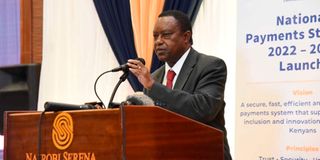PS says borrowing is still within limits set by Parliament

National Treasury Principal Secretary Julius Muia who has dispelled claims that the government has exceeded the Sh9 trillion public debt limit.
National Treasury Principal Secretary Julius Muia has dispelled claims that the government has exceeded the Sh9 trillion public debt limit.
The debt ceiling was set in November 2019 to check the wanton borrowing by the national government.
Dr Muia told the Public Accounts Committee (PAC) of the National Assembly that all borrowing by the government is properly guided by the law.
This comes after Garissa Township MP Aden Duale demanded that the National Assembly summons Treasury Cabinet Secretary Ukur Yattani to explain why the government has exceeded the debt limit without the approval of Parliament as required by the law.
Mr Duale, in a request for a statement from the House Committee on Finance and National Planning, says the violation of the debt cap is largely due to guaranteed debts to various state agencies.
However, Dr Muia told PAC, chaired by Ugunja MP Opiyo Wandayi, that Sh8.4 trillion is the current status of the national debt stock.
Guaranteed debts
But he admitted that guaranteed debts are also public debts, especially when the borrowing entity fails to meet its obligations.
“We have a limit of Sh9 trillion and for every single borrowing, we have to get a certificate of clearance from the Office of the Attorney-General,” said Dr Muia.
With a deficit of Sh846 billion in the proposed Sh3.32 trillion budget for the 2022/23 financial year, it means that the government can only borrow up to Sh400 billion to finance the budget unless it gets some headroom by repaying some of the loans.
Already, the National Treasury is pushing to have the Public Finance Management (National Government) Regulations 2015 amended to have the national debt ceiling pegged at 55 per cent of the Gross Domestic Product (GDP) projections as opposed to the current specific shilling figure.
This is notwithstanding that the country’s current debt is already beyond 55 per cent of GDP mark.
Debt ceiling
In November 2019, Parliament changed the law to have a debt ceiling in numerical figure as opposed to GDP proportion. It was then envisaged that the limit would be in line with the fiscal consolidation plan.
Mr Duale is using data submitted to Parliament by the National Treasury to put the CS to task. The data shows that at the end of June 2021, the total disbursed and undisbursed loans stood at Sh9.04 trillion. This includes guaranteed debt of Sh158.78 billion to Kenya Airways, Kenya Power, Kengen, Kenya Railways and Kenya Ports Authority.
“It is against this background that I seek a statement from the committee chairperson on the total loan commitments to date, including a breakdown by lender and the terms of repayment,” Mr Duale says in his request.
According to Treasury, the nominal public debt stock, including guaranteed debt, stood at Sh7.74 trillion, about 69.07 per cent of the country’s GDP, as at the end of June 2021.
As the public debt expands, its servicing is proving to be a major concern and limiting the availability of cash to support other budgetary expenditures. This financial year, the government is spending in the region of Sh1.17 trillion, about 9 percent of the GDP, on public debt servicing.
Mr Duale wants the committee to list all government agencies that failed to draw down their loan balances on time, leading to utilisation of public debts to pay commitment fees of about Sh1.66 billion as of June 30, 2021.
The committee is also required to include the action the Treasury CS has taken against the various government agencies for the imprudent use of public money contrary to the principle of public finance.





